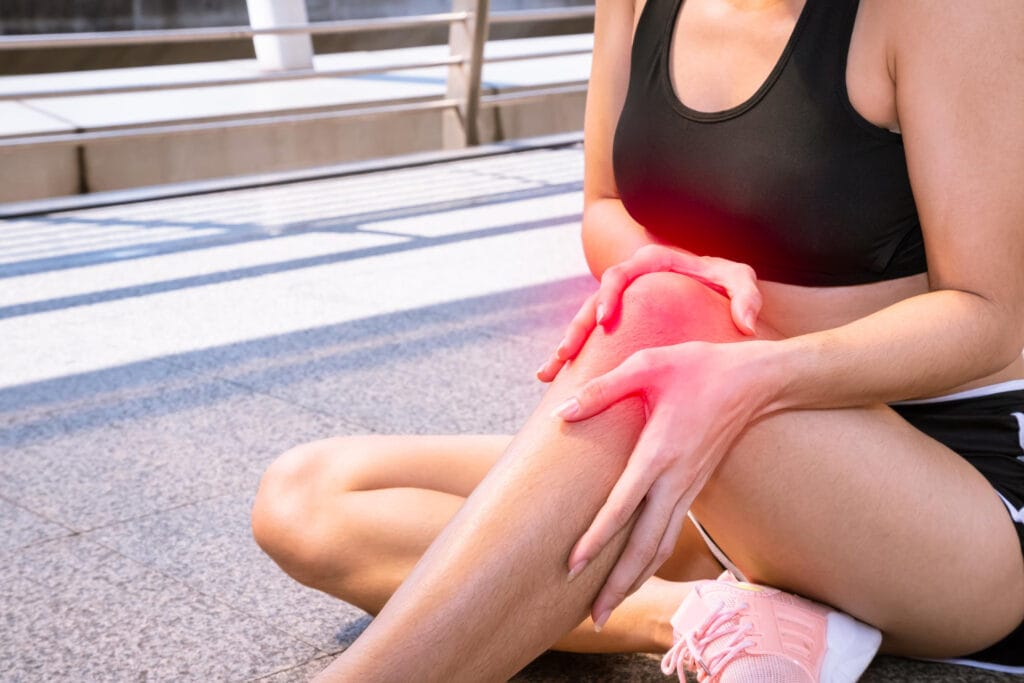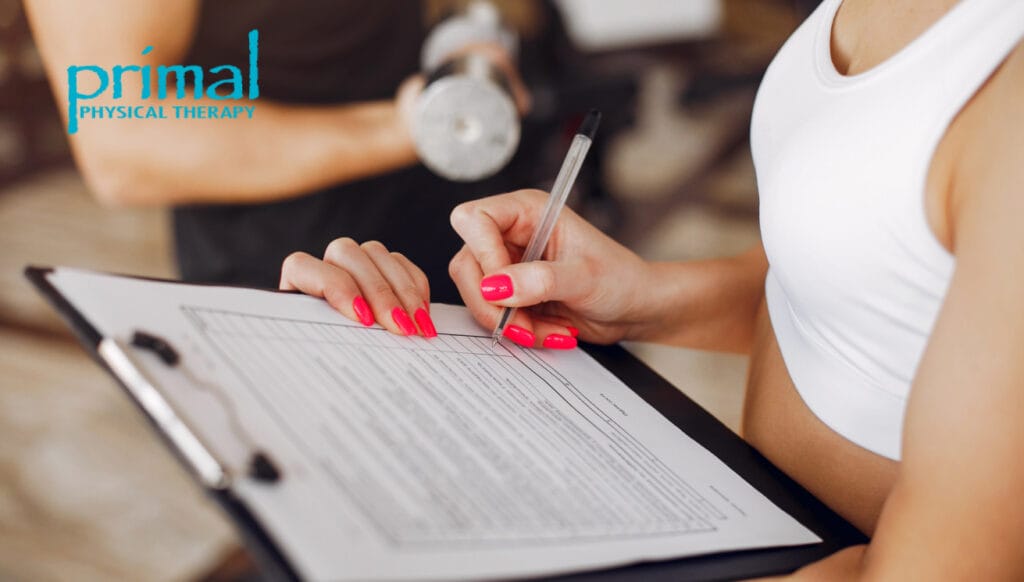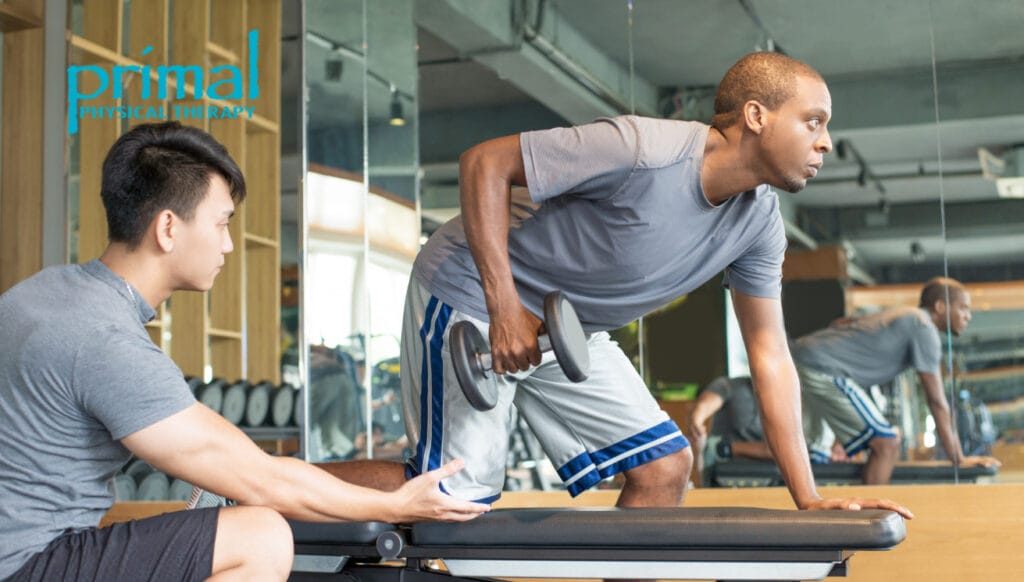Fact Checked By: Dr. JJ Thomas, DPT, CMTPT, FDNS
“There is no ghost so difficult to lay as the ghost of an injury” – Alexander Smith
Knee injuries are among the most common serious injuries, accounting for 60% of high school sport-related surgeries1. The majority of ACL injuries have been described as occurring without athlete-to-athlete contact; often, they involve landing, jumping, or pivoting.
We are starting to see more and more exercise-based ACL injury prevention protocols in high school sports to mitigate the frequency of knee injuries. There are a lot of protocols and resources out there on how to best recover from an ACL injury if one were to occur.
In this blog, we will go through the research and present how to get back to sport/activity following an ACL reconstruction surgery the most efficient way possible.

Understanding ACL Injuries
The Anterior Cruciate Ligament (ACL) anatomically is attached from the tibia to the femur. The ACL has two separate bundles that wrap around each other as the knee bends: the anteriomedial bundle and the posterolateral bundle. It functions as the primary restraint against forward (anterior) translation of the tibia on the femur.
In addition to anterior translation forces, the ACL also provides some stability of rotation of the knee through all planes of internal/external rotation and varus/valgus angulations.
Because of the anatomy of the ACL, it is susceptible to injury in any combined planes of motion with the knee bent. In sports, this includes cutting, pivoting, and jumping/landing, as these all have multiple planes of motion associated with a bent knee. This may also be why the prevalence is so high amongst athletes and across sports, as the ACL provides a wide range of stability in several planes of motion.
According to the AAOS (American Academy of Orthopaedic Surgeons), there are three levels of severity of ACL injuries. Grade 1 sprains are classified as the ligament being mildly damaged but still able to keep the knee joint stable. Grade 2 sprains stretch the ligament to the point where it becomes loose: this is also known as a partial tear. Grade 3 sprains, commonly referred to as complete tears, have been torn in half or pulled directly off the bone, making the knee joint unstable2.
ACL tears can be accompanied by injuries to other tissues in the knee, including the meniscus, cartilage, and the other knee ligaments (MCL, PCL, LCL). The most common injury associated with an ACL tear is a meniscus tear. Either the medial (inside) or lateral (outside) meniscus can be torn with an ACL tear. Sprains or tears of the MCL can also be associated with an ACL tear and are common in patients who injure their ACL while skiing.
An ACL injury can happen during any sport or activity. Common symptoms of a torn ACL include a popping sound at the time of injury, knee pain, swelling, and knee instability, especially during weight-bearing activity. There are several ways for a Physical Therapist to diagnose an ACL tear through testing and physical examination, but an MRI is still the gold standard for a diagnosis of a torn ACL.
Pre-Surgery Considerations
Prehabilitation refers to rehab prior to surgery for ACL reconstruction. The goals of physical therapy prior to surgery are to address loss of motion, quadricep weakness, and instability. Prehabilitation will improve balance, proprioception, and confidence, which will all help prevent reinjury after reconstruction.
A good indicator for potential successful prehabilitation is the ability to achieve 80% quadricep strength compared to the unaffected side. Patients who achieve this milestone minimize their chance of persistent strength differences for up to 2 years post-surgery3. Our brain also benefits from prehabilitation as it increases proprioceptive input despite having a torn ACL. Rewiring our brains and allowing sufficient input to the cortex of the injured leg can greatly improve awareness and mental preparedness post-surgery.

Surgical Approaches
There are several different options on how to repair a torn ACL ligament. They are separated into what we call Autograft (meaning from within our own body) and Allograft (meaning from another body). Autograft options include our patellar tendon, quadriceps tendon, or hamstring tendon as options to anchor the ACL after being fully torn. While there are some differences in recovery depending on where the graft is taken from, within 2 years post-surgery, there were no significant differences in the internal stability of the knee.
ACL reconstruction surgery techniques have been relatively standardized with improvements in technology and anchoring devices, making for a better graft repair. There have been new practices of ACL repair that involved using as much of prior ACL tissue as possible, but there has not been any research of high quality, long-term outcomes as these have just started to appear in the last year.
Most patients with a torn ACL are given between 3-6 weeks prior to surgery to ensure that swelling goes down, they’re able to regain motion and mobility through the knee, and improve strength as mentioned prior in prehabilitation to ensure desired outcomes post ACL reconstruction.
Here, we will display a projection of what to expect after ACL surgery and generalized timelines for return to sport and activity. No patient undergoing this surgery is the same despite efforts to standardize care after ACL reconstruction. At Primal, we make sure we treat the body as a system and as a whole and integrate the injured leg with the rest of our bodies.
Phase 1: The Foundation Phase (Weeks 1-4)
Immediate inflammation and swelling post-surgery are to be expected. The graft is still beginning to incorporate tunnels, resulting in a weak link. Inflammation is required for necessary cells and tissue to begin to bind to the scaffolding of the graft that will later form into the ligament.
The main range of motion (ROM) criterion of this phase is to achieve 0 degrees extension as quickly as possible post-surgery. The general goals are to achieve 90 degrees of flexion by the end of week 2 and be within 10 degrees of the other limb by the end of week 4.
There are several techniques and advancements in early neuromuscular re-education, including biofeedback tools, neuromuscular stimulation (NMES), radiation and mirror neuron activation with similar contractions of non-involved extremity, and even the use of augmented reality to facilitate the brain-injury relation of neuroplasticity.
Maintaining a positive outlook and trusting the process of recovery can be difficult for a lot of athletes. The emphasis is to take it one day at a time and set attainable goals to strive towards at the expected timeline.

Phase 2: The Strength Restoration Phase (Weeks 5-12)
There have been a lot of advancements in the definition and quantitative measurements of quadriceps control and strength in this phase of recovery. The goal is to achieve 80% strength in this phase compared to the other extremity and loading with single leg squats down to 90 degrees of flexion to increase eccentric demands of the quadriceps ms group.
Progressively loading and adding more dynamic activities in this phase, achieving multitasking and preparedness of sport will encourage tissue healing and loading that is important for optimal recovery. Balancing between quadriceps and hamstring ratio is important for innate stability in single leg stance and single leg squatting to achieve a dynamic stability throughout an entire range. Adding different terrain textures and increasing the plyometric demand will also encourage tissue healing and strengthening dynamically.
Here at Primal Physical Therapy, backed by research, we believe that core stability and cross-training of upper body dynamics improve outcomes in this phase of recovery to ensure a trunk-first strategy of loading from the head/neck and shoulder girdle all the way down to our pinky toe. Ensuring our system is functioning as a whole will encourage optimum movement strategies to discourage compensatory strategies that may affect the up and down kinetic chain that is commonly seen in this phase of recovery.
Phase 3: Functional Restoration Phase (Months 3-6)
This phase of recovery is very patient-specific and sport-specific, depending on the three-dimensional demands of each sport, as discussed earlier. New advancements in technology allow us to see dynamic motions with monitors and sensors to ensure efficient body mechanics through planes of motion. Different sports also have different balances of fast/slow twitch response training to be ingrained into rehabilitation. Emphasis on power for sprinting, cutting, and jumping or emphasis on endurance for long-distance runners and crew.
Objective strength recommendations by the end of this phase are 90-100% of strength compared to uninvolved extremity, a >95% hop test, and >95% Y-balance test scores as a return to sport metrics to avoid reinjury. To measure psychological readiness for return to sport, there is an ACL-Return to Sport after Injury (ACL-RSI) scale that is scored at 6 months to predict return to competition sport at 12 months. This scale helps differentiate between emotional factors and confidence in the performance of tasks in return to sport activity.
Phase 4: Return-to-Sport Progression (Months 6-9)
This stage of recovery is completely patient-independent. The fine-tuning of systemic integration, muscular strength and power output training, and return to sport progressions all are patient-specific metrics. Comprehensive testing of strength is now switching from a dynamometer of >95% strength at one given point in space to now requiring to achieve that level of strength in a variety of postures and positions. This transcends gross muscle strength and is the required neuromuscular rehabilitation for a return to sport activity. It can be difficult to measure objectively, which is why we train hard and consistently to facilitate optimal healing.
Above is an example of how we can stage a return to sport activity and training to achieve desired outcomes that we can adapt to each individual patient’s sport. By breaking down complex motions and challenges into its finite pieces and measuring them, we are able to best ensure every spect of training has been challenged appropriately.
Creating realistic practice environments while controlling for any harmful variables can help physically and mentally in returning to sport and activity. Especially in contact sports, there may be some internal fear of reinjury that needs to be carefully reintegrated into practice environments where no actual harm can occur.
As mentioned previously, the ACL-RSI is the most commonly used tool to measure psychological readiness for return to sport training after an ACL injury. Objectively, it should show improvements since the previous phase of recovery. Fear of re-injury and being relaxed about playing sport were the two most important nodes in the network models that describe the return to sport readiness. The importance of knee confidence at influencing psychological readiness was greater in athletes who did return to sport compared to those who did not10
The First Year Back: Post-Return Monitoring
After the first year, all chemistry and healing that will occur has occurred already from a healing standpoint. No athlete or injury is exactly the same, and different sports require different monitoring and training strategies before being cleared for a full return to sport activity. Training for sport and peak performance metrics prior to injury are good objective tools to measure percentage return. Some athletes may already be in their sport competing and others still may need continued monitoring and specific task training. This is up to the team, including the physician, athletic trainer, and physical therapist, on a case-by-case basis.
Embracing the Journey Back to Peak Performance
A lot of time, research, and effort goes into any ACL injury. It may feel daunting at first, but remembering to be patient and respect the healing process is critical in recovery and return to sport activity for any athlete. Having objective measurement tools and a high-quality physical therapy team behind your back, there is no obstacle or challenge that cannot be met.
Our goal as the Primal Physical Therapy team is to ensure efficient recovery and to return stronger than before as a well-integrated machine.
References
Joseph AM, Collins CL, Henke NM, Yard EE, Fields SK, Comstock RD. A Multisport Epidemiologic Comparison of Anterior Cruciate Ligament Injuries in High School Athletics. Journal of Athletic Training. 2013;48(6):810-817. doi:https://doi.org/10.4085/1062-6050-48.6.03
OrthoInfo. ACL Injury: Does It Require Surgery? – OrthoInfo – AAOS. Aaos.org. Published September 2009. https://orthoinfo.aaos.org/en/treatment/acl-injury-does-it-require-surgery/
Cunha J, Solomon DJ. ACL Prehabilitation Improves Postoperative Strength and Motion and Return to Sport in Athletes. Arthroscopy, Sports Medicine, and Rehabilitation. 2022;4(1):e65-e69. doi:https://doi.org/10.1016/j.asmr.2021.11.001
Macaulay AA, Perfetti DC, Levine WN. Anterior Cruciate Ligament Graft Choices. Sports Health: A Multidisciplinary Approach. 2011;4(1):63-68. doi:https://doi.org/10.1177/1941738111409890
Bosco F, Rovere G, Giustra F, et al. Advancements in Anterior Cruciate Ligament Repair—Current State of the Art. Surgeries. 2024;5(2):234-247. doi:https://doi.org/10.3390/surgeries5020022
Irfan A, Kerr S, Hopper G, Wilson W, Wilson L, Mackay G. A Criterion Based Rehabilitation Protocol for ACL Repair with Internal Brace Augmentation. International Journal of Sports Physical Therapy. 2021;16(3):870-878. doi:https://doi.org/10.26603/001c.22217
ACL Reconstruction Protocol: Department of Rehabilitation Services Physical Therapy Anterior Cruciate Ligament Reconstruction: Post-Operative Protocol. https://www.brighamandwomens.org/assets/BWH/patients-and-families/rehabilitation-services/pdfs/acl-protocol.pdf
Webster KE, Feller JA. Psychological Readiness to Return to Sport After Anterior Cruciate Ligament Reconstruction in the Adolescent Athlete. Journal of Athletic Training. 2022;57(9-10):955-960. doi:https://doi.org/10.4085/1062-6050-0543.21
Draovitch P, Patel S, Marrone W, et al. The Return-to-Sport Clearance Continuum Is a Novel Approach Toward Return to Sport and Performance for the Professional Athlete. Arthroscopy, Sports Medicine, and Rehabilitation. 2022;4(1):e93-e101. doi:https://doi.org/10.1016/j.asmr.2021.10.026
Liew BXW, Feller JA, Webster KE. Understanding the psychological mechanisms of return to sports readiness after anterior cruciate ligament reconstruction. Evans R, ed. PLOS ONE. 2022;17(3):e0266029. doi:https://doi.org/10.1371/journal.pone.0266029